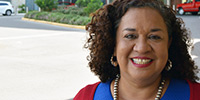
When her youngest child was close to graduating from high school, Rosemarie Ramos decided to return to college and finish her degree in biology. The decision would lead her down an unexpected career path in public health, engaging patients and addressing health disparities, such as the difficulty among the Latina community in accessing pre- and postnatal care that she had witnessed more than a decade before as a young wife and mother in San Antonio, Texas.
While completing her undergraduate research program, Ramos spent 12 weeks at the National Institutes of Health (NIH) in Bethesda, Maryland, where she was exposed to social researchers studying gene-by-environment interaction. They spoke about health disparities and the need for social and behavioral science to be integrated with hard science in order to address, reduce, and eventually eliminate health disparities and improve treatment outcomes.
For Ramos it was her first ‘aha moment.’
"I thought ‘That’s it.’ That’s what I was looking for: the opportunity to integrate my basic biology knowledge—the nerdy part of me—with the social and behavioral aspects of population health that I felt were so perplexing."
This was how she ended up taking a train from Bethesda to Pittsburgh and sitting across the table from professors Evelyn Talbot and Lewis Kuller to discuss Pitt Public Health’s programs.
While Ramos left impressed by the school’s breadth—covering both biological variability and social factors—and fully prepared to apply, it was a personal invitation from Patrick Koty in environmental and occupational health (EOH) and that department’s close ties with epidemiology that led her to choose EOH as her academic home.
As part of her interest in geographic trends of asthma disparities and related complications among adults in Pittsburgh—a project that would later become her dissertation—Ramos volunteered for a brand-new outreach program during her first semester at Pitt Public Health. Dubbed Take a Health Professional to the People Day, the initiative is now housed in the Center for Health Equity, still partnering with Black-owned barbershops in the city. Students join doctors, nurses, and other health and human services providers to engage with, educate, and offer health screenings to community members. As one of the program’s earliest participants, Ramos was simply hoping to talk to people about the importance of getting a flu shot, especially for asthmatics.
Over the next four-and-a-half years, Ramos observed how the program fostered engagement within the Black community "on their terms, to discuss the issues most important to them." She served on one of the center’s community research advisory boards, made up not of academics but of "students, nurses, public school teachers, moms, dads, and grandparents." She saw what could be accomplished when researchers "emerge from their silos, walk across the street, and communicate directly with medical professionals and lay people."
And then she had her biggest ‘aha moment.’
"That’s when I discovered there’s so much distrust among communities of color toward the health care system," she says. The lack of trust she observed in Pittsburgh’s African American community "was the same distrust I heard about anecdotally from the Latino population in South Texas. So I began to think: Health disparity is not a function of skin color, race, or ability to articulate the English language; it’s a function of communication and opportunity.
"Communication barriers are powerful social determinants of health disparities. When we as health care organizations and community public health leaders fail to communicate on a level where individuals, irrespective of their educational attainment, appreciate and respect each other, then disparities continue to prevail. Today, I view such social determinants of health not as barriers but as golden opportunities."
Ramos says this perspective—along with the lessons she learned and the self-confidence she gained at Pitt Public Health—still informs her work today. As a faculty member and assistant research program director in the Department of Emergency Medicine at the University of Texas Health Science Center at San Antonio, she’s able to apply her expertise in chronic disease management to address disparities and engage patients when they are at their most vulnerable. She believes now is an extremely exciting time to work in public health. "The intersection of public health and medicine creates limitless opportunities."
Ramos still keeps in touch with faculty members she respected as mentors but today values as colleagues, including professor Patricia Documet and Meryl Karol, her thesis advisor. She credits LinkedIn and the Pitt Public Health reception at the APHA annual meeting with helping her to stay in contact with Pitt Public Health friends, now spread all over the country at universities and places like the NIH, DHHS, and CDC.
12/22/2016